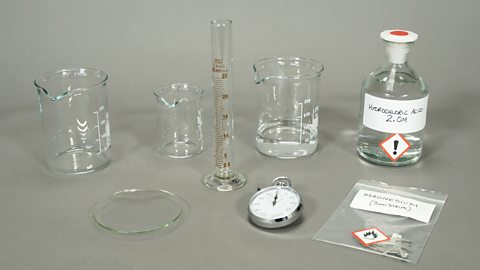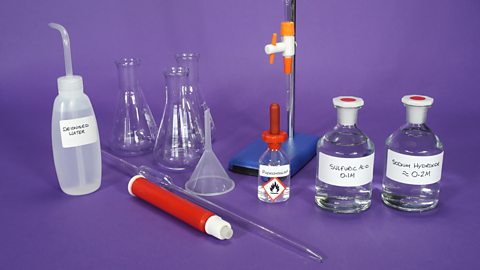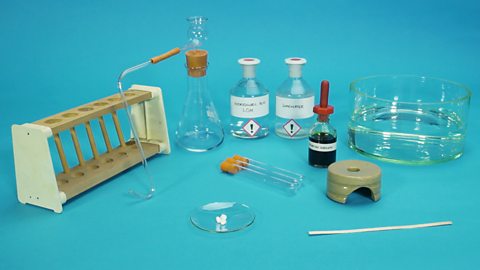What are the key learning points about prescribed practical C5?
In displacement reaction a more reactive metal displaces (takes the place of) a less reactive metal from its compoundA pure substance made from two or more elements which are chemically bonded in a fixed ratio. .
The reactivity of a range of metals can be compared by carrying out displacement reactions between the different metals.
The most reactive metal will be able to displace all of the other metals from their compounds.
What is the purpose of prescribed practical C5?
The reactivity of metals can be determined using displacement reactions.
In a displacement reaction a more reactive metal will displace a less reactive metal from its compound.
For example, magnesium is a more reactive metal than copper, so can displace copper(II) ions from copper(II) sulfate:
magnesium + copper(II) sulfate → magnesium sulfate + copper
Essentially, the magnesium and copper ‘swap’ places.
In this experiment we will determine the relative reactivity of 4 metals: copper, iron, zinc, and magnesium.
In order to determine the relative reactivity of each metal we will carry out displacement reactions by reacting each metal with a solution of every other metal ionAn atom or molecule that has either a positive or negative electrical charge..
If the metal is more reactive than the metal in a solution (present as an ion), then a displacement reaction will occur and we will observe a change in the reaction.
What apparatus is required for investigating the reactivity of metals?
Test-tube rack
Test-tubes x3
Copper(II) sulfate solution (0.5 mol/dm3)
Magnesium sulfate solution (0.5 mol/dm3)
Zinc sulfate solution (0.5 mol/dm3)
Iron(II) sulfate solution (0.5 mol/dm3)
Pieces of copper foil (3 small pieces approx. 1 cm2)
Zinc (3 small granules or pieces of foil approx. 1 cm2)
Iron (3 small ungalvanised nails)
Magnesium ribbon (3 small pieces 1 cm length)
What happens when testing the reactivity of copper (Cu)?
Investigate the reactivity of copper
What steps are involved in investigating the reaction of copper (Cu)?
Half-fill separate test-tubes with magnesium sulfate, iron(II) sulfate and zinc sulfate solutions.
Add a piece of copper to each test-tube.
Leave for 3 minutes, record observations.
Observations
| Name of Solution | Observations at the start | Observations after 3 minutes | Displacement reaction? Yes/No |
|---|---|---|---|
| magnesium sulfate | |||
| iron(II) sulfate | |||
| zinc sulfate |
What happens when testing the reactivity of iron (Fe)?
Investigate the reactivity of iron.
What steps are involved in investigating the reactivity of iron (Fe)?
Half-fill separate test-tubes with copper(II) sulfate, magnesium sulfate and zinc sulfate solutions.
Add a piece of iron to each test-tube.
Leave for 3 minutes, record observations.
Observations
| Name of Solution | Observations at the start | Observations after 3 minutes | Displacement reaction? Yes/No |
|---|---|---|---|
| copper sulfate | |||
| magnesium sulfate | |||
| zinc sulfate |
What happens when testing the reactivity of zinc (Zn)?
Testing the reactivity of zinc.
What steps are involved in investigating the reactivity of zinc (Zn)?
Half-fill separate test-tubes with copper(II) sulfate, magnesium sulfate and iron(II) sulfate solutions.
Add a piece of zinc to each test-tube.
Leave for 3 minutes, record observations.
Observations
| Name of Solution | Observations at the start | Observations after 3 minutes | Displacement reaction? Yes/No |
|---|---|---|---|
| copper(II) sulfate | |||
| magnesium sulfate | |||
| iron(II) sulfate |
What happens when testing the reactivity of magnesium (Mg)?
Testing the reactivity of magnesium.
What steps are involved in testing the reactivity of magnesium (Mg)?
Half-fill separate test-tubes with copper(II) sulfate, iron(II) sulfate and zinc sulfate solutions.
Add a piece of magnesium to each test-tube.
Leave for 3 minutes, record observations.
Observations
| Name of Solution | Observations at the start | Observations after 3 minutes | Displacement reaction? Yes/No |
|---|---|---|---|
| copper(II) sulfate | |||
| zinc sulfate | |||
| iron(II) sulfate |
How much do you know about testing the reactivity of metals?
More on Unit 3: Prescribed practicals
Find out more by working through a topic
- count6 of 9

- count8 of 9

- count9 of 9
